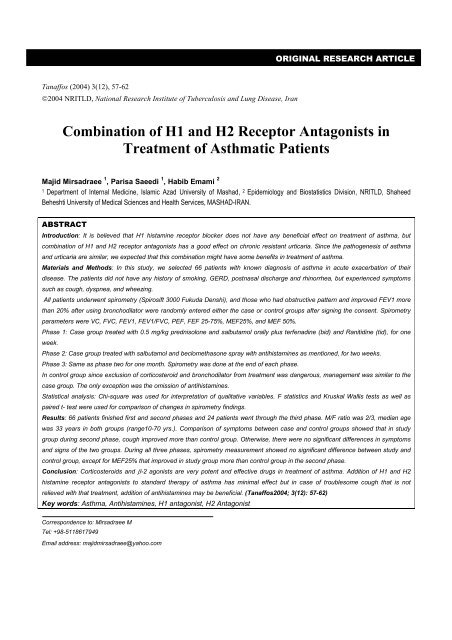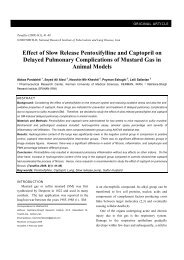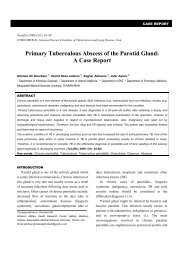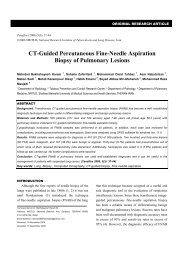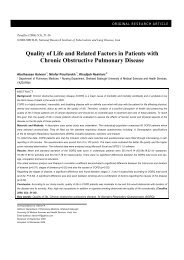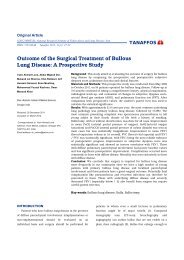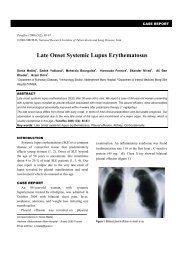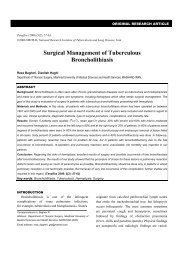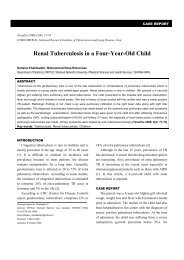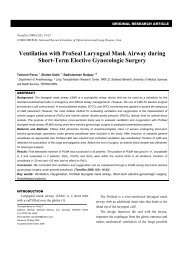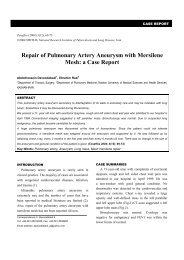Combination of H1 and H2 Receptor Antagonists in ... - Tanaffos
Combination of H1 and H2 Receptor Antagonists in ... - Tanaffos
Combination of H1 and H2 Receptor Antagonists in ... - Tanaffos
You also want an ePaper? Increase the reach of your titles
YUMPU automatically turns print PDFs into web optimized ePapers that Google loves.
1<br />
ORIGINAL RESEARCH ARTICLE<br />
<strong>Tanaffos</strong> (2004) 3(12), 57-62<br />
©2004 NRITLD, National Research Institute <strong>of</strong> Tuberculosis <strong>and</strong> Lung Disease, Iran<br />
<strong>Comb<strong>in</strong>ation</strong> <strong>of</strong> <strong>H1</strong> <strong>and</strong> <strong>H2</strong> <strong>Receptor</strong> <strong>Antagonists</strong> <strong>in</strong><br />
Treatment <strong>of</strong> Asthmatic Patients<br />
Majid Mirsadraee 1 , Parisa Saeedi 1 , Habib Emami 2<br />
1<br />
Department <strong>of</strong> Internal Medic<strong>in</strong>e, Islamic Azad University <strong>of</strong> Mashad, 2 Epidemiology <strong>and</strong> Biostatistics Division, NRITLD, Shaheed<br />
Beheshti University <strong>of</strong> Medical Sciences <strong>and</strong> Health Services, MASHAD-IRAN.<br />
ABSTRACT<br />
Introduction: It is believed that <strong>H1</strong> histam<strong>in</strong>e receptor blocker does not have any beneficial effect on treatment <strong>of</strong> asthma, but<br />
comb<strong>in</strong>ation <strong>of</strong> <strong>H1</strong> <strong>and</strong> <strong>H2</strong> receptor antagonists has a good effect on chronic resistant urticaria. S<strong>in</strong>ce the pathogenesis <strong>of</strong> asthma<br />
<strong>and</strong> urticaria are similar, we expected that this comb<strong>in</strong>ation might have some benefits <strong>in</strong> treatment <strong>of</strong> asthma.<br />
Materials <strong>and</strong> Methods: In this study, we selected 66 patients with known diagnosis <strong>of</strong> asthma <strong>in</strong> acute exacerbation <strong>of</strong> their<br />
disease. The patients did not have any history <strong>of</strong> smok<strong>in</strong>g, GERD, postnasal discharge <strong>and</strong> rh<strong>in</strong>orrhea, but experienced symptoms<br />
such as cough, dyspnea, <strong>and</strong> wheez<strong>in</strong>g.<br />
All patients underwent spirometry (Spirosift 3000 Fukuda Denshi), <strong>and</strong> those who had obstructive pattern <strong>and</strong> improved FEV1 more<br />
than 20% after us<strong>in</strong>g bronchodilator were r<strong>and</strong>omly entered either the case or control groups after sign<strong>in</strong>g the consent. Spirometry<br />
parameters were VC, FVC, FEV1, FEV1/FVC, PEF, FEF 25-75%, MEF25%, <strong>and</strong> MEF 50%.<br />
Phase 1: Case group treated with 0.5 mg/kg prednisolone <strong>and</strong> salbutamol orally plus terfenad<strong>in</strong>e (bid) <strong>and</strong> Ranitid<strong>in</strong>e (tid), for one<br />
week.<br />
Phase 2: Case group treated with salbutamol <strong>and</strong> beclomethasone spray with antihistam<strong>in</strong>es as mentioned, for two weeks.<br />
Phase 3: Same as phase two for one month. Spirometry was done at the end <strong>of</strong> each phase.<br />
In control group s<strong>in</strong>ce exclusion <strong>of</strong> corticosteroid <strong>and</strong> bronchodilator from treatment was dangerous, management was similar to the<br />
case group. The only exception was the omission <strong>of</strong> antihistam<strong>in</strong>es.<br />
Statistical analysis: Chi-square was used for <strong>in</strong>terpretation <strong>of</strong> qualitative variables. F statistics <strong>and</strong> Kruskal Wallis tests as well as<br />
paired t- test were used for comparison <strong>of</strong> changes <strong>in</strong> spirometry f<strong>in</strong>d<strong>in</strong>gs.<br />
Results: 66 patients f<strong>in</strong>ished first <strong>and</strong> second phases <strong>and</strong> 24 patients went through the third phase. M/F ratio was 2/3, median age<br />
was 33 years <strong>in</strong> both groups (range10-70 yrs.). Comparison <strong>of</strong> symptoms between case <strong>and</strong> control groups showed that <strong>in</strong> study<br />
group dur<strong>in</strong>g second phase, cough improved more than control group. Otherwise, there were no significant differences <strong>in</strong> symptoms<br />
<strong>and</strong> signs <strong>of</strong> the two groups. Dur<strong>in</strong>g all three phases, spirometry measurement showed no significant difference between study <strong>and</strong><br />
control group, except for MEF25% that improved <strong>in</strong> study group more than control group <strong>in</strong> the second phase.<br />
Conclusion: Corticosteroids <strong>and</strong> β-2 agonists are very potent <strong>and</strong> effective drugs <strong>in</strong> treatment <strong>of</strong> asthma. Addition <strong>of</strong> <strong>H1</strong> <strong>and</strong> <strong>H2</strong><br />
histam<strong>in</strong>e receptor antagonists to st<strong>and</strong>ard therapy <strong>of</strong> asthma has m<strong>in</strong>imal effect but <strong>in</strong> case <strong>of</strong> troublesome cough that is not<br />
relieved with that treatment, addition <strong>of</strong> antihistam<strong>in</strong>es may be beneficial. (<strong>Tanaffos</strong>2004; 3(12): 57-62)<br />
Key words: Asthma, Antihistam<strong>in</strong>es, <strong>H1</strong> antagonist, <strong>H2</strong> Antagonist<br />
Correspondence to: Mirsadraee M<br />
Tel: +98-5118617949<br />
Email address: majidmirsadraee@yahoo.com
58 <strong>H1</strong> <strong>and</strong> <strong>H2</strong> <strong>Antagonists</strong> <strong>in</strong> Treatment <strong>of</strong> Asthma<br />
INTRODUCTION<br />
Asthma is a common cl<strong>in</strong>ical condition <strong>and</strong> new<br />
treatments could help to improve this state <strong>and</strong> the<br />
quality <strong>of</strong> patients’ life. <strong>H1</strong> receptor blockers are not<br />
known to be effective <strong>in</strong> the treatment <strong>of</strong> Asthma (1).<br />
However, a comb<strong>in</strong>ation <strong>of</strong> <strong>H1</strong> <strong>and</strong> <strong>H2</strong> receptor<br />
antagonists are thought to be effective <strong>in</strong> the<br />
treatment <strong>of</strong> chronic resistant urticaria (3). As there<br />
are similarities <strong>in</strong> the immunological pathogenesis <strong>of</strong><br />
asthma <strong>and</strong> urticaria, we designed this study to<br />
evaluate the effect <strong>of</strong> <strong>H1</strong> <strong>and</strong> <strong>H2</strong> antagonist<br />
comb<strong>in</strong>ation on symptoms <strong>and</strong> physiologic<br />
parameters <strong>of</strong> asthma.<br />
MATERIALS AND METHODS<br />
We performed a prospective, r<strong>and</strong>omised <strong>and</strong><br />
controlled cl<strong>in</strong>ical trial <strong>in</strong> outpatient cl<strong>in</strong>ic <strong>of</strong> Aria<br />
hospital (Mashad) to evaluate the effect <strong>of</strong> <strong>H1</strong> <strong>and</strong><br />
<strong>H2</strong> antagonist comb<strong>in</strong>ation on asthma outcome.<br />
1- Patient selection:<br />
Newly diagnosed chronic asthmatic patients or<br />
those diagnosed for the first time with acute<br />
exacerbation were assigned equally <strong>in</strong>to study <strong>and</strong><br />
control groups by block r<strong>and</strong>omisation. Criteria for<br />
the enrolment <strong>of</strong> asthmatic patients were based on<br />
cl<strong>in</strong>ical manifestations (cough, dyspnea, <strong>and</strong> wheeze)<br />
<strong>and</strong> spirometry exam<strong>in</strong>ations (Spirosift 3000 Fukuda<br />
Denshi). Criteria for spirometry exam<strong>in</strong>ation result<br />
<strong>in</strong>cluded an obstructive pattern with an improved<br />
FEV1 <strong>of</strong> more than 20% after bronchodilator usage.<br />
Patients with a history <strong>of</strong> smok<strong>in</strong>g <strong>and</strong> resistant<br />
asthma were excluded from the study.<br />
2- Medical treatment:<br />
Patients were treated <strong>in</strong> three phases. These<br />
phases were 1 week, 2 weeks <strong>and</strong> 1 month <strong>in</strong> length,<br />
respectively. All patients received a st<strong>and</strong>ard<br />
treatment <strong>of</strong> prednisolone (0.5 mg/kg/day) <strong>and</strong> oral<br />
salbutamol (2mg/tid) <strong>in</strong> phase one followed by<br />
salbutamol (2 puff/tid) <strong>and</strong> beclomethasone<br />
spray (4 puffs tid after salbutamol) <strong>in</strong> the second <strong>and</strong><br />
third phases. In addition to the above mentioned<br />
treatments, the study group received a comb<strong>in</strong>ation<br />
<strong>of</strong> terfenad<strong>in</strong>e (one tab twice daily) <strong>and</strong> ranitid<strong>in</strong>e<br />
(150mg three times daily). Dur<strong>in</strong>g the study, contact<br />
with well known stimulatory agents was prohibited.<br />
3- Outcome measurement:<br />
A questionnaire was used to monitor the cl<strong>in</strong>ical<br />
improvement <strong>of</strong> asthma symptoms <strong>and</strong> signs (cough<br />
dyspnea <strong>and</strong> wheeze). Spirometry exam<strong>in</strong>ation was<br />
performed at the end <strong>of</strong> each phase. Lung function<br />
parameters <strong>in</strong>cluded VC, FVC, FEV1, PEF, FEF 25-<br />
75%, <strong>and</strong> MEF 25%. A percentile ratio <strong>of</strong> the<br />
exam<strong>in</strong>ed parameters to the predicted values was<br />
calculated <strong>and</strong> the outcome was measured by the<br />
calculation <strong>of</strong> changes. Chi square, F statistics <strong>and</strong><br />
Kruskal Wallis tests were used to compare the<br />
outcome measurements <strong>in</strong> both groups.<br />
Ethical considerations: The project was approved by<br />
the Medical School Research Committee. We<br />
obta<strong>in</strong>ed <strong>in</strong>formed consent from all patients to take<br />
part <strong>in</strong> the study. Due to dangers <strong>of</strong> acute asthma, we<br />
did not omit glucosteroid <strong>and</strong> salbutamol usage <strong>in</strong><br />
control group.<br />
RESULTS<br />
66 patients (36 cases <strong>and</strong> 30 controls) f<strong>in</strong>ished the<br />
first <strong>and</strong> second phases. Forty- two patients dropped<br />
out from the third phase (because <strong>of</strong> complete<br />
resolution or other unknown reasons related to<br />
patients themselves) <strong>and</strong> only 24 patients f<strong>in</strong>ished<br />
this phase. Male to female ratio was 2 to 3. Median<br />
age was 33 years <strong>in</strong> general (range 10-70 yrs.). The<br />
median age for case <strong>and</strong> control groups was 36 <strong>and</strong><br />
24 years, respectively.<br />
In the first phase, the symptoms <strong>and</strong> signs <strong>of</strong><br />
asthma improved significantly <strong>in</strong> both study <strong>and</strong><br />
control groups (cough, dyspnea <strong>and</strong><br />
wheeze)(p=0.0002) (table1). However, there was no<br />
significant difference between the two groups<br />
<strong>Tanaffos</strong> 2004; 3(12): 57-62
Mirsadraee M, et al. 59<br />
(p=0.26). In the second phase, cough symptom<br />
improved more significantly <strong>in</strong> the case than the<br />
control group (p=0.041) (table 2). No other<br />
significant difference <strong>in</strong> symptoms <strong>and</strong> signs was<br />
noted between the two groups. In the third phase,<br />
symptoms did not get better <strong>and</strong> there was no<br />
significant difference between the two groups.<br />
Table 1. Summary <strong>of</strong> cl<strong>in</strong>ical f<strong>in</strong>d<strong>in</strong>gs <strong>in</strong> patients with asthma treated<br />
with <strong>H1</strong> <strong>and</strong> <strong>H2</strong> blocker<br />
Spirometry exam<strong>in</strong>ation showed that at the end <strong>of</strong><br />
each treatment phase, there were significant<br />
improvements <strong>in</strong> the air flow (p=0.0001) (table 3).<br />
However, there was no significant difference <strong>in</strong> the<br />
rate <strong>of</strong> improvement <strong>in</strong> the first <strong>and</strong> third phases<br />
between the study <strong>and</strong> control groups (p=0.090). In<br />
the second phase, however, MEF 25%, improved<br />
more significant <strong>in</strong> the study group than the control<br />
(p=0.05). In this phase, there was no other significant<br />
statistical difference <strong>in</strong> the lung function parameters.<br />
Cl<strong>in</strong>ical<br />
f<strong>in</strong>d<strong>in</strong>gs<br />
Cough<br />
Dyspnea<br />
Wheeze<br />
Phase <strong>of</strong><br />
treatment<br />
Asymptomatic<br />
Mild<br />
Moderate<br />
Total<br />
P value <strong>of</strong> case<br />
control<br />
First 3 13 50 66 0.15<br />
Second 35 27 4 66 0.025<br />
Third 13 8 3 24 0.36<br />
First 1 18 47 66 0.37<br />
Second 49 17 0 66 0.15<br />
Third 17 4 3 24 0.4<br />
First 0 10 52 62 0.25<br />
Second 22 29 13 64 0.2<br />
Third 11 9 4 24 0.5<br />
Table 2. Improvement <strong>of</strong> cough <strong>in</strong> second phase <strong>of</strong> treatment <strong>of</strong> asthma<br />
with <strong>H1</strong> <strong>and</strong> <strong>H2</strong> blocker<br />
Positive history<br />
<strong>of</strong> cough<br />
Negative history<br />
<strong>of</strong> cough<br />
With <strong>H1</strong> <strong>and</strong> <strong>H2</strong> blocker 13 25<br />
Without <strong>H1</strong> <strong>and</strong> <strong>H2</strong> blocker 18 10<br />
Table 3. The most important spirometric results <strong>of</strong> second phase <strong>of</strong><br />
treatment <strong>of</strong> asthmatic patients with <strong>H1</strong> <strong>and</strong> <strong>H2</strong> blocker<br />
VC<br />
FVC<br />
FEV1<br />
PEF<br />
PEF 25-75%<br />
Case 20.44 17.7 17.2 20 21 24.2<br />
Control 15.14 17 20.4 18.1 19.5 18.4<br />
p- value 0.23 0.25 0.38 0.65 0.76 0.35<br />
MEF 25%<br />
DISCUSSION<br />
Asthma is one <strong>of</strong> the most common obstructive<br />
lung diseases. Bronchial hypersensitivity lead<strong>in</strong>g to<br />
bronchial <strong>in</strong>flammation <strong>and</strong> spasm which is<br />
secondary to exogenous <strong>and</strong> somehow unknown<br />
material is thought to be the aetiology <strong>of</strong> asthma.<br />
Allergens first b<strong>in</strong>d to the IgE on the surface <strong>of</strong><br />
mastocytes. This leads to release <strong>of</strong> many mediators<br />
(such as histam<strong>in</strong>e) which <strong>in</strong>duces or enhances an<br />
asthma attack (type-I hypersensitivity). Histam<strong>in</strong>e<br />
receptors <strong>in</strong> target organs consist <strong>of</strong> two types: <strong>H1</strong><br />
<strong>and</strong> <strong>H2</strong> receptors are present <strong>in</strong> the bronchi <strong>and</strong> other<br />
organs (1,2,3).<br />
Early studies showed that block<strong>in</strong>g <strong>H1</strong> receptor<br />
was effective <strong>in</strong> the treatment <strong>of</strong> ord<strong>in</strong>ary (4,5,6) <strong>and</strong><br />
exercise asthma (7). However, later studies<br />
disapprove the role <strong>of</strong> <strong>H1</strong> blockers <strong>in</strong> the complete<br />
resolution <strong>of</strong> asthma (8,9). Ketotifen as a new <strong>H1</strong><br />
blocker later proved to have some efficacy aga<strong>in</strong>st<br />
asthma (10, 11).<br />
<strong>H2</strong> receptors are ma<strong>in</strong>ly present <strong>in</strong> heart <strong>and</strong><br />
stomach (12). Eyre <strong>in</strong> 1973 (13) <strong>and</strong> Okpako <strong>in</strong> 1974<br />
(14) found <strong>H2</strong> receptors <strong>in</strong> the bronchi <strong>of</strong> cat, sheep<br />
<strong>and</strong> Gu<strong>in</strong>ea pig. A further <strong>in</strong>-vitro study by Dunlop et<br />
al. showed <strong>H2</strong> receptor <strong>in</strong> human bronchi (15).<br />
In 1973, Lichtenste<strong>in</strong> et al. suggested that<br />
<strong>in</strong>hibition <strong>of</strong> histam<strong>in</strong>e effect was only possible by<br />
the blockage <strong>of</strong> <strong>H2</strong> receptors rather than the <strong>H1</strong><br />
receptors. This effect was dose dependent (16). A<br />
<strong>Tanaffos</strong> 2004; 3(12): 57-62
60 <strong>H1</strong> <strong>and</strong> <strong>H2</strong> <strong>Antagonists</strong> <strong>in</strong> Treatment <strong>of</strong> Asthma<br />
recent research on CD3 cells from bronchoalveolar<br />
lavage <strong>and</strong> peripheral blood <strong>of</strong> normal <strong>and</strong> asthmatic<br />
patients showed that histam<strong>in</strong>e can <strong>in</strong>crease IFN- γ,<br />
IL5, IL4 <strong>and</strong> <strong>in</strong>tracellular CAMP. These effects can<br />
be blocked by <strong>H2</strong> antagonist (17) which is important<br />
<strong>in</strong> asthma pathogenesis. Maconochie et al. (1) used<br />
<strong>H1</strong> <strong>and</strong> <strong>H2</strong> antagonists <strong>in</strong> 9 healthy volunteers who<br />
experienced asthma symptoms after <strong>in</strong>halation <strong>of</strong><br />
histam<strong>in</strong>e. In this article, it was showed that <strong>H1</strong> <strong>and</strong><br />
<strong>H2</strong> antagonists can not block the asthmatic change <strong>in</strong><br />
volunteers, <strong>and</strong> these drugs can not substitute for the<br />
st<strong>and</strong>ard treatment <strong>of</strong> asthma by us<strong>in</strong>g glucocorticoid<br />
<strong>and</strong> leukotriene <strong>in</strong>hibitors (18, 19, 20, 21).Therefore,<br />
we considered a larger sample size <strong>and</strong> exam<strong>in</strong>ed the<br />
effect <strong>of</strong> the treatment on true asthamtic patients.<br />
Our results show that antihistam<strong>in</strong>es have some<br />
effect on bronchospasm <strong>and</strong> most importantly can<br />
reduce cough symptoms <strong>in</strong> patients. The treatment<br />
should consist <strong>of</strong> adm<strong>in</strong>istration <strong>of</strong> a <strong>H2</strong> antagonist or<br />
comb<strong>in</strong>ation <strong>of</strong> <strong>H1</strong> <strong>and</strong> <strong>H2</strong> receptor antagonists. This<br />
recommendation is more useful <strong>in</strong> patients with<br />
gastroesophageal reflux <strong>and</strong> those who experience<br />
reflux with β2-agonists <strong>and</strong> methylxanth<strong>in</strong>es because<br />
these two drugs cause GERD.<br />
REFERENCES<br />
1. Maconochie JG, Wood<strong>in</strong>gs EP, Richards DA. Effects <strong>of</strong> <strong>H1</strong>-<br />
<strong>and</strong> <strong>H2</strong>-receptor block<strong>in</strong>g agents on histam<strong>in</strong>e-<strong>in</strong>duced<br />
bronchoconstriction <strong>in</strong> non-asthmatic subjects. Br J Cl<strong>in</strong><br />
Pharmacol 1979; 7 (3): 231-6.<br />
2. Casterl<strong>in</strong>e CL, Evans R. Further studies on the mechanism<br />
<strong>of</strong> human histam<strong>in</strong>e-<strong>in</strong>duced asthma: the effect <strong>of</strong> an<br />
aerosolized <strong>H1</strong> receptor antagonist (diphenhydram<strong>in</strong>e). J<br />
Allergy Cl<strong>in</strong> Immunol 1977; 59 (6): 420-4.<br />
3. Meltzer EO. The use <strong>of</strong> anti-<strong>H1</strong> drugs <strong>in</strong> mild asthma.<br />
Allergy 1995; 50 (24 Suppl): 41-7.<br />
4. Rafferty P, Holgate ST. Terfenad<strong>in</strong>e (Seldane) is a potent <strong>and</strong><br />
selective histam<strong>in</strong>e <strong>H1</strong> receptor antagonist <strong>in</strong> asthmatic<br />
5. Chan TB, Shelton DM, Eiser NM. Effect <strong>of</strong> an oral <strong>H1</strong>-<br />
receptor antagonist, terfenad<strong>in</strong>e, on antigen-<strong>in</strong>duced asthma.<br />
Br J Dis Chest 1986; 80 (4): 375- 84.<br />
6. Cookson WO. Bronchodilator action <strong>of</strong> the anti-histam<strong>in</strong>ic<br />
terfenad<strong>in</strong>e. Br J Cl<strong>in</strong> Pharmacol 1987; 24 (1): 120- 1.<br />
7. Clee MD, Ingram CG, Reid PC, Robertson AS. The effect <strong>of</strong><br />
astemizole on exercise-<strong>in</strong>duced asthma. Br J Dis Chest 1984;<br />
78 (2): 180-3.<br />
8. Schuller DE. Adverse effects <strong>of</strong> brompheniram<strong>in</strong>e on<br />
pulmonary function <strong>in</strong> a subset <strong>of</strong> asthmatic children. J<br />
Allergy Cl<strong>in</strong> Immunol 1983;72 (2): 175-9.<br />
9. White J, Eiser NM. The role <strong>of</strong> histam<strong>in</strong>e <strong>and</strong> its receptors <strong>in</strong><br />
the pathogenesis <strong>of</strong> asthma. Br J Dis Chest 1983; 77 (3):<br />
215-26.<br />
10. Kabra SK, P<strong>and</strong>ey RM, S<strong>in</strong>gh R, Seth V. Ketotifen for<br />
asthma <strong>in</strong> children aged 5 to 15 years: a r<strong>and</strong>omized placebocontrolled<br />
trial. Ann Allergy Asthma Immunol 2000; 85 (1):<br />
46-52.<br />
11. Hosh<strong>in</strong>o M, Nakamura Y, Sim JJ, Tomioka H. A<br />
comparative study <strong>of</strong> the effects <strong>of</strong> ketotifen, disodium<br />
cromoglycate, <strong>and</strong> beclomethasone dipropionate on bronchial<br />
mucosa <strong>and</strong> asthma symptoms <strong>in</strong> patients with atopic asthma.<br />
Respir Med 1998; 92 (7): 942-50.<br />
12. Smythe MA, Zarowitz BJ. Chang<strong>in</strong>g perspectives <strong>of</strong> stress<br />
gastritis prophylaxis. Ann Pharmacother 1994; 28 (9): 1073-<br />
85.<br />
13. Eyre P. Histam<strong>in</strong>e <strong>H2</strong>-receptors <strong>in</strong> the sheep bronchus <strong>and</strong><br />
cat trachea: the action <strong>of</strong> burimamide. Br J Pharmacol 1973;<br />
48 (2): 321-3.<br />
14. Okpako DT. A vasodepressor action <strong>of</strong> histam<strong>in</strong>e mediated<br />
by <strong>H2</strong>-receptor activation. Eur J Pharmacol 1974; 29 (1):<br />
10- 4.<br />
15. Dunlop LS, Smith AP, Piper PJ. The effect <strong>of</strong> histam<strong>in</strong>e<br />
antagonists on antigen-<strong>in</strong>duced contractions <strong>of</strong> sensitized<br />
human bronchus <strong>in</strong> vitro [proceed<strong>in</strong>gs]. Br J Pharmacol<br />
1977; 59 (3): 475 P.<br />
16. Lichtenste<strong>in</strong> LM, Gillespie E. Inhibition <strong>of</strong> histam<strong>in</strong>e release<br />
by histam<strong>in</strong>e controlled by <strong>H2</strong> receptor. Nature 1973; 244<br />
(5414): 287- 8.<br />
airways. Am Rev Respir Dis 1987; 135 (1): 181-4.<br />
<strong>Tanaffos</strong> 2004; 3(12): 57-62
Mirsadraee M, et al. 61<br />
17. Krouwels FH, Hol BE, Lutter R, Bru<strong>in</strong>ier B, Bast A, Jansen<br />
HM, Out TA. Histam<strong>in</strong>e affects <strong>in</strong>terleuk<strong>in</strong>-4, <strong>in</strong>terleuk<strong>in</strong>-5,<br />
<strong>and</strong> <strong>in</strong>terferon-gamma production by human T cell clones<br />
from the airways <strong>and</strong> blood. Am J Respir Cell Mol Biol<br />
1998; 18 (5): 721- 30.<br />
18. Williams RO 3rd, Patel AM, Barron MK, Rogers TL.<br />
Investigation <strong>of</strong> some commercially available spacer devices<br />
for the delivery <strong>of</strong> glucocorticoid steroids from a pMDI.<br />
Drug Dev Ind Pharm 2001; 27 (5): 401- 12.<br />
19. Ek<strong>in</strong>s-Daukes S, Simpson CR, Helms PJ, Taylor MW,<br />
McLay JS. Burden <strong>of</strong> corticosteroids <strong>in</strong> children with asthma<br />
<strong>in</strong> primary care: retrospective observational study. BMJ<br />
2002; 324 (7350): 1374.<br />
20. McMillan RM. Leukotrienes <strong>in</strong> respiratory disease. Paediatr<br />
Respir Rev 2001; 2 (3): 238- 44.<br />
21. Tohda Y, Kubo H, Iwanaga T, Fukuoka M, Nakajima S.<br />
Influence <strong>of</strong> theophyll<strong>in</strong>e on activated lymphocytes <strong>and</strong><br />
eos<strong>in</strong>ophils <strong>in</strong> peripheral blood <strong>and</strong> sputum. J Int Med Res<br />
2001; 29 (6): 528-36.<br />
<strong>Tanaffos</strong> 2004; 3(12): 57-62


